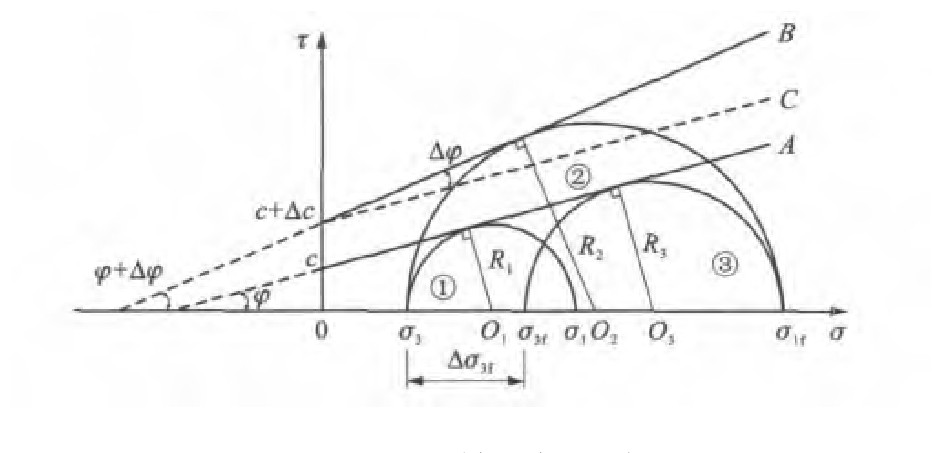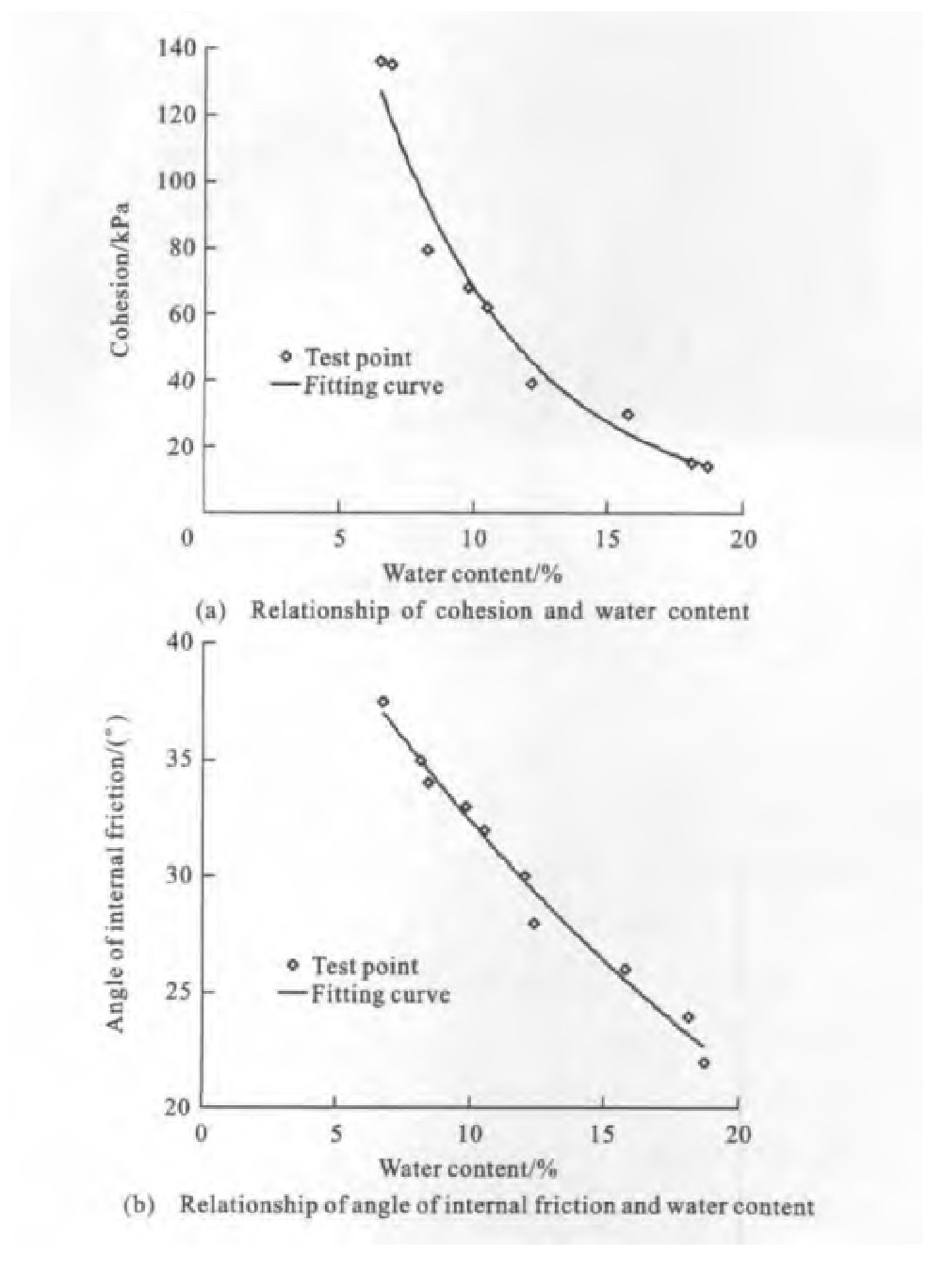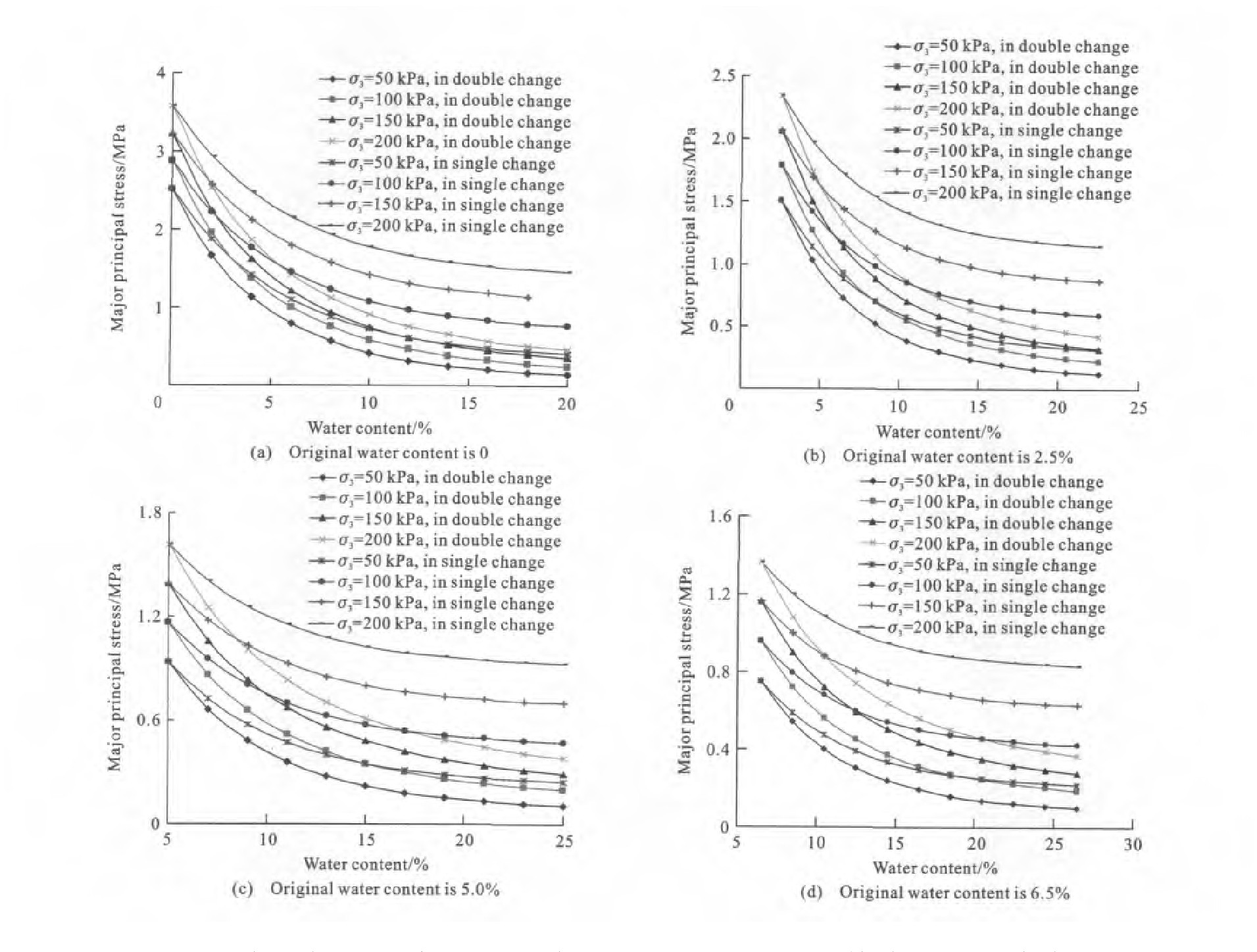Effect of water content on strength of unsaturated loess
-
Abstract: Loess suction's contribution to its strength was regarded as the increment of minor principal stress.The increment was gained by analyzing the Mohr's circle geometric figure of loess ultimate stress.When loess was in ultimate state at failure, a computation method of loess strength was put forward under the condition that the cohesion and the internal friction angle synchronously changed, the relationship between the strength indexes and water content was obtained, and the relationship curves of major principal stress and water content of unsaturated loess were analyzed at failure.Computation result shows that the changing rules of computation curves and test curves for major principal stress are same, their difference becomes smaller with the increase of water content, the maximum is 11.63%, and the minimum is 1.59%, so the method is credible.With the increase of water content, when the cohesion and the internal friction angle both change, the computation value of major principal stress is larger than the value only when the cohesion changes, their relative error range is 1.26-2.17 times, which indicates that the influence of water content on the strength of unsaturated loess is significant.摘要: 将非饱和土基质吸力对土体强度的贡献等效为小主应力增量, 通过分析土体极限应力莫尔圆的几何图形, 求得小主应力增量, 并认为土体在破坏时处于极限状态, 提出了粘聚力和内摩擦角同时变化时的土体强度计算方法, 得到了强度参数随含水量变化的函数关系式, 研究了非饱和黄土破坏时大主应力随含水量变化的关系曲线。分析结果表明:计算曲线与试验曲线的变化规律相同, 随着含水量的增大, 大主应力计算值和实测值的差异越来越小, 其相对误差最大值为11.63%, 最小值为1.59%, 说明该计算方法是可靠的;随着含水量的增大, 当粘聚力和内摩擦角同时变化时, 大主应力计算值较小, 当仅有内摩擦角变化时, 大主应力计算值较大, 两者相差1.26~2.17倍, 说明含水量的变化对非饱和黄土的强度有显著影响。
-
0. Introduction
Loess covers plenty of areas in Northwest China and North China and often is unsaturated.The strength property of unsaturated loess is complicated, and is an urgent and difficult problem[1]in slope, subgrade and tunnel design.Many scholars studied the strength of unsaturated soil.In general, the measurement of suction is conducted through sensitive ceramic plate or ceramic tube element[2-7], the balance of water-air interface lasts over one week, therefore, one complete laboratory experiment on unsaturated soil's strength needs over one month, so that a lot of researches on unsaturated soil are still conducted in laboratory.So in this paper, the suction's contribution to the strength of soil is regarded as the increment of minor principal stress or confining pressure, through getting the increment, a function of the strength of unsaturated loess respecting to the increments of strength indexes is gotten, and the relationship between the strength and water content of unsaturated soil is set up to predict and analyse the strength of unsaturated soil.
1. Calculation method of strength of unsaturated loess
There are some air and water in the pores of unsaturated soil.The difference between pore air pressure Ua and pore water pressure Uw is called suction Ua -Uw. Many test results demonstrate that the suction makes the strength of unsaturated soil increase, the larger the suction is, the larger the shear strength of unsaturated soil is.
In the analysis of the strength of unsaturated soil, the suction's contribution to the strength as confining pressure is considered.Referencing to previous results on reinforced soil[8-9], the funtion on the ultimate strength of unsaturated soil is gotten while the angle of internal friction and the cohesion increase, and the derivation for the funtion is just as following.
The failure envelope is a straight line, in which, its inclination is φ+Δφ, its intercept is c+Δc, φ is the angle of internal friction, Δφ is the increment of angle of internal friction, c is the cohesion, Δc is the increment of cohesion, and their relationship is shown in Fig. 1.
In Fig. 1, τ is shear stress, σ is normal stress, and O1-O3 are the centers of Mohr's circle 1-3 respectively. Mohr's circle 1 represents no suction, its radius is R1 , and its failure envelope is straight line A.Mohr's circle 2 represents having suction, its radius is R2 , its failure envelope is straight line B, and intersects straight line C that parallels to straight line A.The skeleton of unsaturated soil bears major principal stressσ1 , minor principal stressσ3 and the increment of confining pressure Δσ3f due to the suction, so the failure state corresponds to Mohr's circle 3.At this time, actual minor principal stress is σ3f , the suction provides the additional stress Δσ3f=σ3f -σ3 to the skeleton.The radius of circle 3 is R3 , andσ1f is the major principal stress at failure.From Fig. 1

For circle 3


For circle 2

Which leads to

Δσ3f is obtained by substituting Eq.(2)and Eq.(3)into Eq.(1)


The limit equilibrium equation for soil is just as following

σ1 is obtained by substituting Eq.(4)into the limit equilibrium equation

Simplifying Eq.(5), it is obtained

in which


From Eq.(6), Δφ makes the generalized confining pressure σ3 increase, and both Δφ and Δc make the generalized cohesion c increase.
2. Comparison of calculation result and test result
Because measuring the suction is very difficult, a plenty of researches on the strength of unsaturated soil are focused on the train of thought of water content-suction-shear strength.With the increase of water content, the suction decreases, and the suction is related to the shear strength closely[10].Making use of the data from the triaxial tests on unsaturated loess[11-12], the relationships of the cohesion and the angle of internal friction with water content are obtained by using the leastsquare method, and are shown in Fig. 2 and Tab. 1.In Tab. 1, w is water content, and Δw is its increment.
Table 1. Relationship of strength indexes and water content
From Fig. 2, the cohesion and the angle of internal friction of unsaturated loess decrease with the increase of water content exponentially.If the confining pressure is constant, the larger soil specimen bears axial load, the larger the shear strength of soil specimen is.Substituting the formula between the strength indexes and water content into Eq.(5), the curves of major principal stress and water content are obtained and shown in Fig. 3.
From Fig. 3, the calculation values and test values of major principa stresses decrease with the increase of water content, and their differences become less with the increase of water content.When original water content is 6.9%, the confining pressure is 50kPa, the maximum relative error is 11.63%.When water content is 6.9%, the minimum relative error is 1.59%.When water content reaches 18.1%, the calculation data are consistent with experimental data.Original water content does not affect the calculation result of major principa stress, which shows that Eq.(5)is appropriate to describe the the strength of unsaturated soil.Using Eq.(5)and Fig. 2, the strengths of unsaturated soil for different water contents can be predicted.
When the cohesion and the angle of internal friction change with water content, and only the cohesion changes with water content, the major principal stresses are calculated by using Eq.(5), and shown in Fig. 4.The major principal stresses calculated in double change are less than that in single change.For a given water content, the difference of major principal stresses in two kinds situations becomes larger with the increase of water content, becomes less with the increase of confining pressure.When original water content is constant, the major principal stress in single change is 2.26to 3.17times more than that in double change, which illustrates that a little change for the cohesion and the angle of internal friction can causes larger change of strength of unsaturated soil, which confirms that Eq.(5)is right for predicting the strength of unsaturated soil.
3. Conclusion
In this paper, the function of the change of major principal stress with the strength index increments of loess is put forward, the curves of strength indexes-water content are analyzed, the major principal stresses in failure state for different water contents are calculated, and the calculation data coincide with the experiment data well.The major principal stress calculated in single change is larger than that in double change, and their difference becomes larger with the increase of water content.
-
Table 1. Relationship of strength indexes and water content

-
[1] LIU Chun, DING Li. Strength characteristics of unsaturated loess based on general tri-axial test[J]. Geology and Prospecting, 2002, 38(5): 89-91. [2] FENG Zhi-yan, QIU Ben-sheng, XIE Ding-yi. Experimental study of triaxial test of loess[J]. Journal of Xi'an University of Architecture and Technology: Natural Science Edition, 2010, 42(6): 803-808. [3] CHEN Hui, WEI Chang-fu, LI Huan, et al. A modified weighing-outflow method for measuring soil-water characteristic curve of unsaturated soils[J]. Rock and Soil Mechanics, 2010, 31(7): 2141-2145, 2152. [4] GUAN Liang, CHEN Zheng-han, HUANG Xue-feng, et al. Study on the strength character of unsaturated loess by three-dimensional tests[J]. Building Science, 2011, 27(11): 55-57, 78. [5] XIE Ni, ZOU Wei-lie, YAN Qiu-rong, et al. Experimental research on response of a loess subgrade slope to artificial rainfall[J]. Journal of Sichuan University: Engineering Science Edition, 2009, 41(4): 31-36. [6] WANG Zhao, ZOU Wei-lie, LI Xia. Measurement and application of suction in unsaturated soils[J]. Journal of SichuanUniversity: Engineering Science Edition, 2004, 36(2): 1-6. [7] LIN Hong-zhou, LU He, LIU Bang-an, et al. Variation of matric suction of unsaturated soil measured by using tensiometer and its engineering practice[J]. Geotechnical Investigation and Surveying, 2007(7): 7-10. [8] LEI Sheng-you. Analysis on the strength property of reinforced earth retaining structure(wall)in the V-shaped gully[J]. Journal of Chongqing Jiaotong University, 2001, 20(1): 65-68, 73. [9] LEI Sheng-you. Study of shear strength of reinforced soils considering soil damage due to reinforcements[J]. Journal of China Three Gorges University: Natural Sciences, 2010, 32(6): 42-46. http://search.cnki.net/down/default.aspx?filename=WHYC201006011&dbcode=CJFD&year=2010&dflag=pdfdown [10] ZHAO Hui-li, ZHANG Mi, LI Zhao-ping. The study of water content influence on unsaturated soil shear strength by test[J]. Journal of Shijiazhuang Railway Institute, 2001, 14(4): 30-33. [11] CHENG Bin. The relationship between shear strength and water content of Q3 loess in North Shaanxi and its engineering applying[D]. Xi'an: Xi'an Coal Research Institute, 2007. [12] DANG Jin-qian, LI Jing. The structural strength and shear strength of unsaturated loess[J]. Journal of Hydraulic Engineering, 2001(7): 79-83, 90. -






 DownLoad:
DownLoad:

 DownLoad:
DownLoad:



 下载:
下载:








